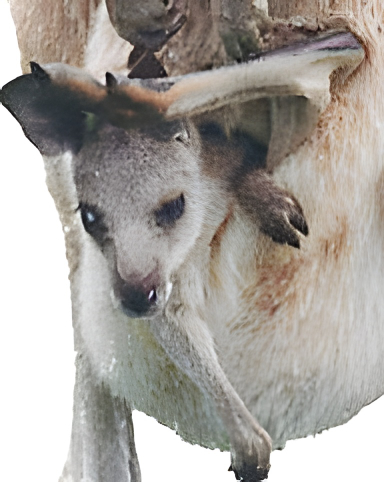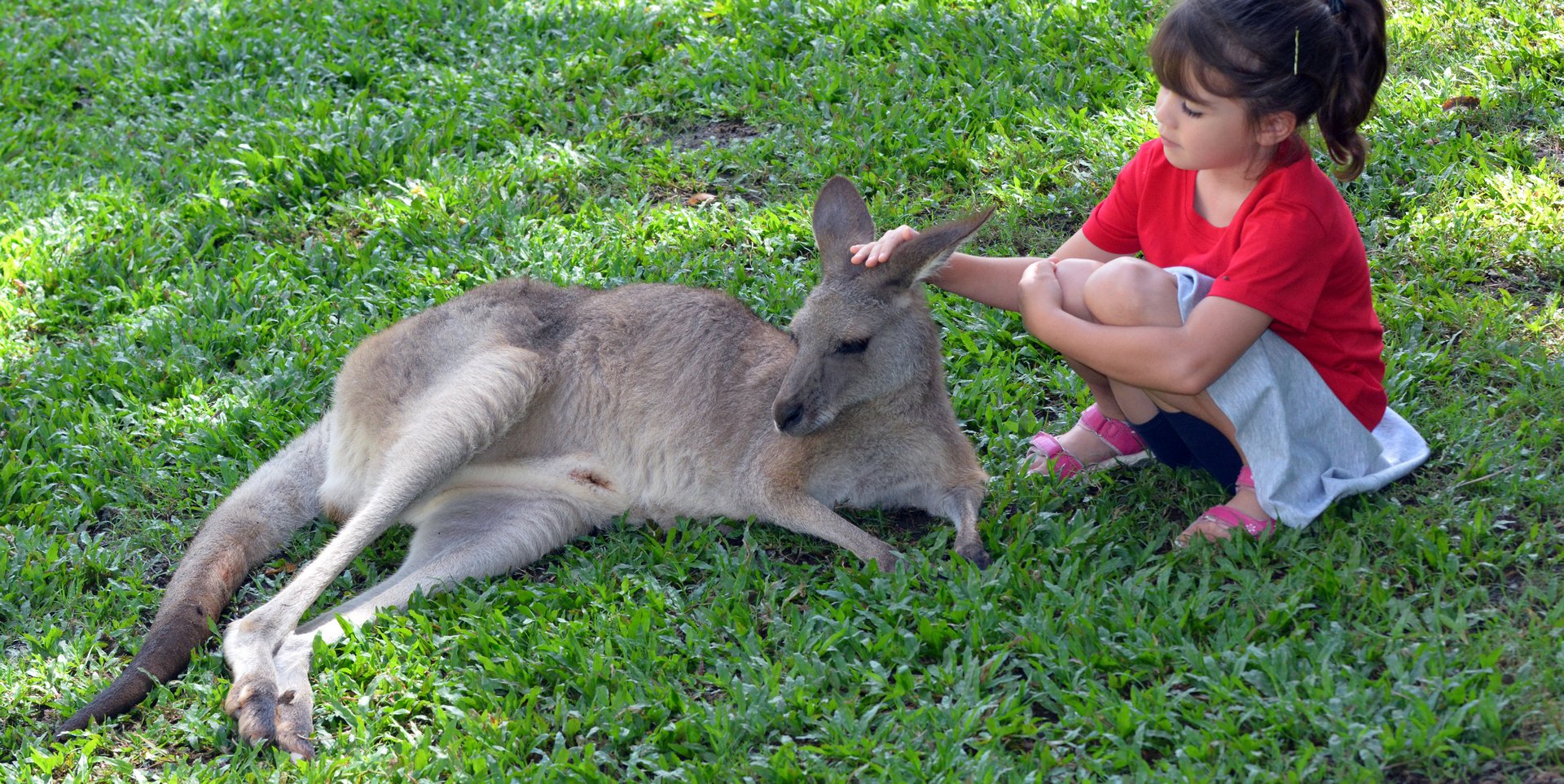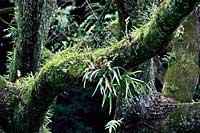Where do they come from? Why the pouch? Why do they hop? How fast are they? Did they evolve from some other animal?

Kangaroos are the symbol of Australia. They appear on Australian postage stamps, coins, and even on their airplanes.
What makes kangaroos so interesting to people? It seems to be the kangaroos’ attractive face, the way they carry their young in a pouch, their amazing leaping power, and their deadly “karate kicking.”
Why the pouch?

Carrying the baby in the pouch is convenient for the female, who may travel many miles for fresh food and water. The youngster stands a greater chance of survival because it does not have to keep up with her. The baby is tucked away, safe from predators.
Another incredible thing about kangaroos is that the mother (called a doe) can determine the sex of her babies. How she does this is unknown, but she tends to put off bearing males until she is older. Males move away after about two years, but females stay with their mothers longer and benefit from mother’s help more.
A doe is nearly always pregnant. All her life, she is rarely without three offspring—an embryo in the womb, a joey in her pouch, and a larger youngster at her heels.
The joey is born after a gestation period of about 35 days (depending on the species) and in the largest species is the size of a human thumb nail. In the smallest, it is only the size of a rice grain. Naked, blind and deaf, it must make its way unaided from the birth canal to the pouch.
All going well, the climb will take less than 10 minutes. The joey can survive only a few minutes unless it reaches the pouch and attaches to one of the four nipples. Once there, its mouth swells on the nipple so that it cannot be removed without injury. A ring of strong muscles, similar to human lips, seals off the opening to the pouch to protect the joey from bouncing out, and keeps the pouch waterproof if mother goes for a swim.
After three months, the developed joey emerges from the pouch to make short trips in the outside world. However, it will return to the pouch to suckle and sleep until eight months old.
How fast are kangaroos?

Why do kangaroos hop?

Hopping appears to be more energy-efficient than running or galloping. The faster kangaroos hop, the less energy they use for the same distance. When scientists put kangaroos on treadmills, they discovered that kangaroos maintain a constant number of hops per minute. Regardless of how much the treadmill speeds up, they simply take longer and longer hops.
Kangaroos function much like bouncing balls. A ball will bounce a number of times without a fresh input of energy. Every time it hits the ground, some of the energy is shifted to the rubber, stored there, then recycled in an elastic bounce. Jumping kangaroos store 70% of their energy in their tendons, compared to running humans, who can store and reuse only about 20%.
A hopping kangaroo also uses less energy to breathe than one standing still. Part of the secret lies in the way the abdominal organs “flop” within the kangaroo’s body. Instead of using muscle power, air is pushed out of the lungs by the impact of the organs against the diaphragm at each landing.
Efficient travel is very beneficial to arid-dwellers such as the Red and Western grey kangaroos, the Tammar wallaby and the euro, which may need to travel long distances between water and food. However, many species inhabit timbered country, with abundant food and regular rainfall.
No evidence of evolution from other animals
Some evolutionary scientists claim that that kangaroos evolved from possums. However, there are no fossils of animals which are part possum and part kangaroo. The oldest kangaroo fossil is clearly a kangaroo, totally and completely (it greatly resembles the potoroos which dwell in Victoria’s forests). If modern kangaroos really did come from it, all this shows is the same as we see happening today, namely that kangaroos come from kangaroos, “after their kind.”
Kangaroos are wonderful examples of God’s craftsmanship, designed by a Creator who knew perfectly what He was doing. To Him all praise, glory and honor is forever due.

Kangaroos vary enormously in size. The tiny, scampering musky rat-kangaroo lives in the tropical rain forests of northern Queensland (Australia). A huge kangaroo called Procoptodon goliah is now extinct and was three times larger than today’s biggest kangaroos. The largest was 8 feet 10 inches (2.7 m) tall and weighed up to 530 pounds (240 kg).
The term “wallaby” is applied to those species where the adult male has a body mass less than about 44 pounds (20 kg) and feet less than 10 inches (25 centimeters) long. However, scientists can find no other major difference between these and kangaroos.

Kangaroos’ superb design, their fascinating way of having babies, and the amazing, energy-efficient way they move is evidence that they were created by God. Kangaroos were not made by Evolution. For example, no baby kangaroos would ever have survived to grow up and make more babies unless the first mother kangaroo’s pouch was designed just right, and the very tiny baby joey was designed with the instinct and ability to find it.
Older students and adults: Read the adult version of this article—more information and references
More answers
 After Noah’s flood, how did animals get from the Ark to isolated places like Australia?
After Noah’s flood, how did animals get from the Ark to isolated places like Australia? Has it ever rained frogs or fish or any other strange things?
Has it ever rained frogs or fish or any other strange things?
Editor: Paul S. Taylor. This article was shortened and adapted for children from an article by Rebecca Driver published by ChristianAnswers.Net—originally published in Creation Ex Nihilo, 20 (3):28-31, June-August 1998. Used by permision.
Text Copyright © 2002, 2023, ChristianAnswers.Net and Creation Ministries International, All Rights Reserved—except as noted on attached “Usage and Copyright” page that grants ChristianAnswers.Net users generous rights for putting this page to work in their homes, personal witnessing, churches and schools. Photographs supplied by Christian Answers.

 DISCOVER BUTTERFLIES—amazing insects of the rainforest
DISCOVER BUTTERFLIES—amazing insects of the rainforest RAIN FOREST PETS—How many do you have at your home?
RAIN FOREST PETS—How many do you have at your home? How might rain forest destruction affect our weather?
How might rain forest destruction affect our weather? DISCOVER ANSWERS to kids’ questions
DISCOVER ANSWERS to kids’ questions